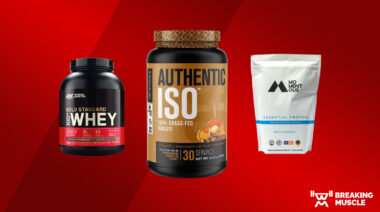Unless you’re an avid reader of anatomy and physiology, you probably haven’t heard of heat shock proteins. Heat shock proteins (HSPs) are an often-overlooked aspect of muscle building that play an important role in the hypertrophy, or muscle building, process.
HSPs not only help increase protein synthesis and stimulate new muscle cells growth, they reduce protein breakdown and help trigger a number of other muscle building pathways.
Unless you’re an avid reader of anatomy and physiology, you probably haven’t heard of heat shock proteins. Heat shock proteins (HSPs) are an often-overlooked aspect of muscle building that play an important role in the hypertrophy, or muscle building, process.
HSPs not only help increase protein synthesis and stimulate new muscle cells growth, they reduce protein breakdown and help trigger a number of other muscle building pathways.
In this article, I’m going to introduce you to the science behind HSPs and why it’s crucial to understand their role if you’re trying to build muscle. Once you’re able to transfer this new knowledge to your training, you’ll see some huge benefits.
What Are Heat Shock Proteins?
Heat shock proteins exist within the cells of all living organisms, making up a large family of proteins that aid in muscle protein synthesis and protect each cell from a variety of protein damaging stressors.
They got their name from original research conducted on hyperthermia. Researchers realised that when exposed to elevated temperatures, these particular “heat shock” proteins increased.
Heat shock proteins are present in a number of different types of cells, including muscle cells. When we place a muscle under stress, such as through exercise, HSPs accumulate to meet the demands placed upon it.
Since their initial discovery, a number of researchers have looked into the expression of HSPs during both cardio and resistance exercise. To date, research has found that exercise- induced decreases in blood flow, increased mechanical stress and decreased glucose all trigger HSP release.1
HSPs are also often referred to as ‘stress proteins’ as they provide us with a hormetic response. This means HSPs protect you from excessive stress and allow positive adaptations, such as increased muscle quality and improved strength, to take place.
This makes heat shock proteins interesting to anyone interested in getting more out of their training.
How Do HSPs Help Muscle Adaptation in Exercise?
Muscle cells respond to resistance exercise in particular by initiating a heat shock stress response, involving a rapid and transient increase in heat shock proteins.2
The HSPs then help to promote lean muscle mass by a process of chaperoning, or assisting, in the repair of cellular damage. They do this by attracting amino acids to damaged sites and encouraging them to convert into new muscle fibres.
HSPs also ensure that the proteins we build for new muscle fit properly by monitoring a process of cell assembly called protein folding. This ensures that new proteins form in the correct shape.
An analogy for this process is to think about the way a lock and key works. If the key isn’t the right shape, no proteins can come through the door.
Real World Evidence of Training Benefits
Eccentric work – a form of resistance training which focuses on lengthening of muscle under control – has been found to significantly elevate a specific type of HSP called HSP70.
One study has shown that repeated maximal eccentric contractions of the quadriceps muscles induced a ~15 fold increase in HSPs, and levels were still elevated 4 days later.3
A similar response was seen in just one session of eccentric training in the biceps too.4
In this study, HSP70 was found to increase by 234% at the 48-hour post-intervention point. Both studies demonstrated that significant muscle damage occurred within a very short time period, and HSP levels increased in relation to muscle damage.
The research provides a promising case for the use of eccentric training for building muscle. With this in mind, athletes should definitely consider adding eccentric work to their programming if they’re chasing muscle mass.
How Else Can HSPs Increase Muscle Mass?
The hypertrophy benefits don’t stop there. The effect of heat shock proteins can also lead to a number of other hypertrophy-supporting mechanisms.
Firstly, HSPs have been found to inhibit reactive oxygen species (ROS) that can lead to protein degradation, as well as increase glutathione, an important peptide for muscle recovery.
Regulation of intracellular calcium may also be improved, which can lead to stimulation of growth hormone and insulin-growth factor 1 (IGF-1).5
HSPs have also been found to trigger growth hormone release via post-workout ‘heat treatment’ in the form of saunas.
When subjects were exposed to twice-daily hour long dry heat saunas for a period of seven days, growth hormone increased 16-fold by day three.6
So a post-workout sauna is another good strategy to further boost the muscle building stimulus of heat shock proteins.
The Science is Clear
Heat shock proteins are proven to play a critical role in the muscle building process, and all of the mechanisms above can help develop your hypertrophy potential.
Take advantage of and maximize these mechanisms with subtle and simple changes to your training. Start with eccentric work and post-workout heat treatments, and wait for the training gains to start rolling in.
Want to find out more about eccentric strength work? Start here:
6 Powerful Benefits of Eccentric Training
References
1. Roshan, VD et al. Heat Shock Protein Responses to Eccentric Weight or Treadmill Exercise in Active Young Females. Sport Sci Health. 2009; 5(2): 75-80
2. Frier, BC & Locke, M. Heat stress inhibits skeletal muscle hypertrophy. Cell Stress Chaperones. 2007; 12(2): 132-141
3.Thompson, HS et al. A single bout of eccentric exercise increases HSP27 and HSC/HSP70 in human skeletal muscle. Acta Physiol Scand. 2001; 171(2): 187-93.
4.Thompson, HS et al. Exercise-induced HSP27, HSP70 and MAPK responses in human skeletal muscle. Acta Physiol Scand. 2003; 178(1): 61-72
5.Beere, HM. `The stress of dying’: the role of heat shock proteins in the regulation of apoptosis. J Cell Sci. 2004 117: 2641-2651
6.Leppaluoto, J. et al. Endocrine effects of repeated sauna bathing. Acta physiologica Scandinavica. 1986; 128:467-470






